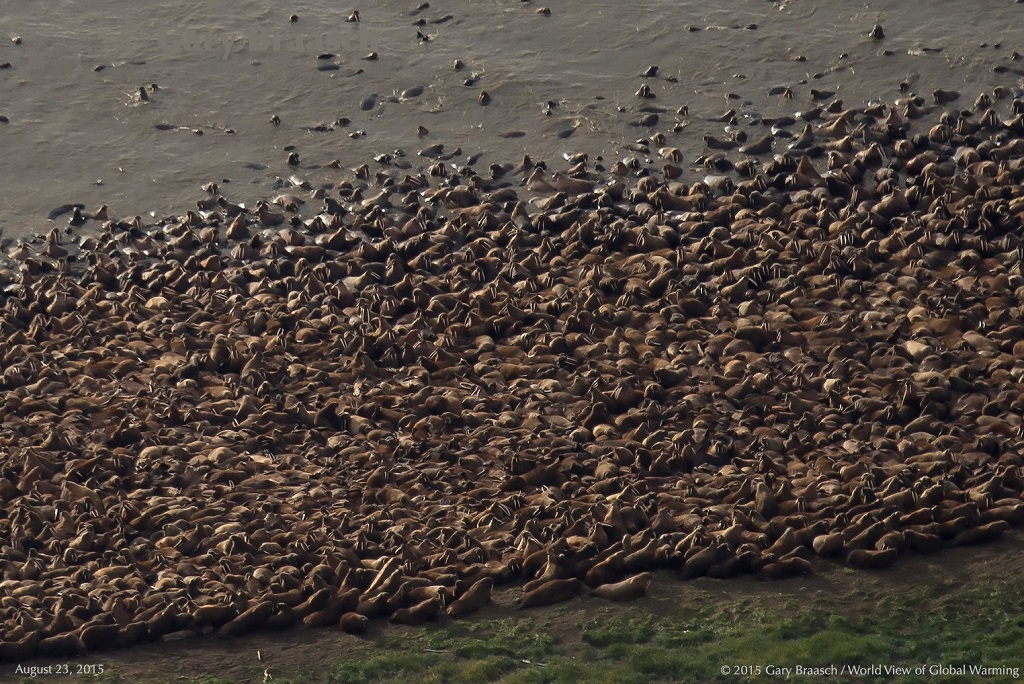We Are The Walrus

(This article originally appeared on AlterNet.)
Literally named the “tooth-walking sea horse,” walrus are one of our most beloved species. They play a central role in the mythology and folklore of Arctic peoples, and were widely hunted during the 19th and early 20th century by those seeking their blubber, meat and ivory tusks. Later they worked their way into popular culture, immortalized in Lewis Carroll’s Alice in Wonderland sequel, Through the Looking Glass, and even The Beatles wrote a song about them.
This century, however, the visibility of the walrus has begun to grow exponentially – even if the polar bear remains the ambassador of climate change to the world. Walrus, the beautiful and quirky creatures that they are, are quickly becoming the public face of climate change in the Arctic and the battle to stop drilling in the Arctic Ocean. And the plight of the walrus serves as a canary in the coal mine for humans as Arctic villages, coastal towns, and ultimately, all of us face our own climate change battles.
Walrus have already made news as it pertains to Shell’s Arctic drilling plans. U.S. Fish and Wildlife Service regulations requiring simultaneous drilling activities to occur at least 15 miles apart forced Shell to abandon its original plans this summer. Despite the fact that the Fish and Wildlife Service made it perfectly clear that Shell would need to adhere to the 15-mile buffer requirement if it was to pursue exploration, Shell’s plans had set its drilling sites only nine miles apart. The Fish and Wildlife Service upheld the 15-mile walrus buffer amidst protests by Shell by requiring that it drill only one well at a time.[i]
But the dangers of drilling extend beyond wildlife disturbance, or even the chance of an oil spill – a risk which happens to be quite high. In late August, just days before President Obama’s historic trip to Alaska, something happened that is quickly becoming more and more common due to a rapidly warming Arctic and the resulting disappearance of sea ice. Walrus, by the thousands, were spotted hauling out on shore. There has been a haul-out nearly every year since 2007, and this event was one of the earliest haul-outs on record.
The reasons for concern are as troubling as the reasons for the haul-outs themselves – walrus are easily spooked on shore, frightened walrus lead to stampedes, and stampeding walrus tend to crush any smaller or baby walrus in their path. Last year, a staggering 35,000 walrus hauled out near the remote village of Point Lay, Alaska, and deaths due to stampedes have numbered in the thousands. And sure enough, last week it was reported that two separate haul-out events were occurring again near Point Lay, estimated again to be near 35,000 animals and growing. The Fish and Wildlife Service made the announcement official just last Thursday.
Our country’s climate future is on full display in Alaska, where warming temperatures are becoming the norm. Record wildfires, melting permafrost and disappearing sea ice underscore the reality that Alaska and America’s Arctic are on the front lines of climate change. The Arctic Ocean plays an important role in regulating the world’s climate, which is bad news as the Arctic is currently warming at about twice the rate of the rest of the world and Arctic waters are quickly becoming more acidic. One powerful way we can slow the effects of climate change is to limit the amount of fossil fuels we are burning, and an effective way to do that is by not opening up new areas to intensive drilling. We must protect the most important ecological areas in the Arctic Ocean.
In 2015, President Obama took concrete steps to protect these areas, which included protecting special places in the Arctic National Wildlife Refuge and Arctic Ocean. In 2016 he should continue to take bold action, including kicking Shell out of the Arctic for good. And if he does, thanks to its increasingly public struggle, we might just have the walrus to thank.
(Side note – photographer and friend of the League Gary Braasch has been documenting the plight of the walrus in the Arctic and the progress of Shell; see Gary’s work online at: https://worldviewofglobalwarming.org/)
[i] Interestingly enough, according to the Houston Chronicle Shell was well aware of this issue as far back as February 2013, when it sent a letter to the agency objecting to the then-proposed rule. Essentially, despite being under a microscope after years of misdeeds, mistakes and failures, Shell knowingly submitted a 2015 drilling plan that violates federal rules put in place to protect imperiled walrus populations.

